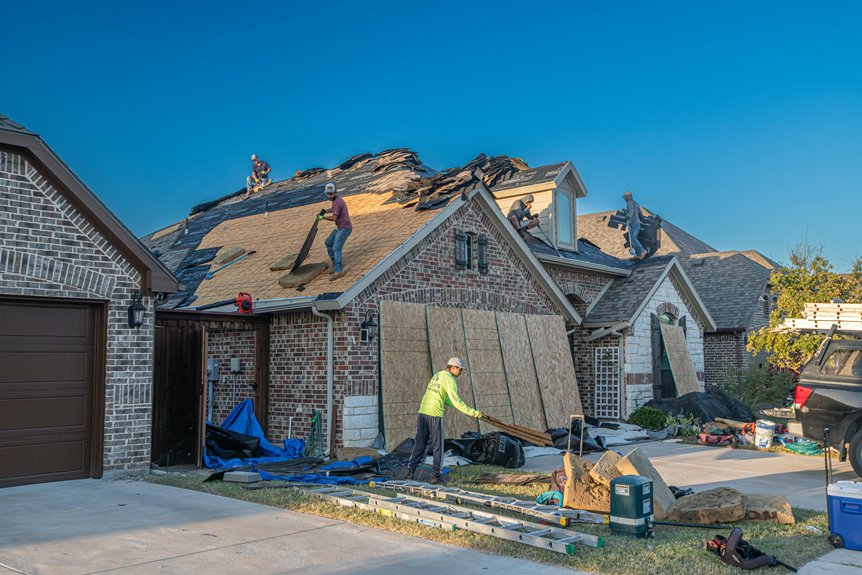As a commercial property owner in Texas, you face the relentless challenge of intense sun exposure that accelerates UV degradation of roofing materials. Without proper protection, your roof materials weaken, chalk, crack, and lose reflectivity, leading to potential leaks and costly repairs. Understanding the specific impacts of UV rays and the available protective measures is essential to extending your roof’s lifespan and maintaining energy efficiency—consider this a key component of your roof management strategy.
The Impact of UV Rays on Roofing Materials
UV rays penetrate roofing materials, accelerating the degradation of their structural components and reducing their overall lifespan. This process involves the breakdown of polymer chains within membranes, leading to surface chalking and loss of elasticity.
The ultraviolet radiation causes photo-oxidative reactions that weaken asphalt binders and compromise the integrity of embedded reinforcement. Over time, UV exposure induces microcracks, increases porosity, and diminishes reflective properties, heightening thermal absorption. Regular roof inspections can help identify early signs of UV-related damage before costly repairs are needed.
As a result, roofing systems become more susceptible to leaks, delamination, and premature failure, demanding costly repairs or replacements. Understanding these mechanisms underscores the importance of UV protective measures to prolong roof durability in high-exposure environments.
Signs of UV Damage on Commercial Roofs
One of the most apparent indicators of UV damage on commercial roofs is the presence of surface chalking, which appears as a powdery residue on the membrane’s surface. This occurs when UV rays degrade the asphalt and polymer components, causing binder breakdown.
You may notice a loss of gloss and increased brittleness, leading to cracking or delamination. Other signs include discoloration, often fading from original hues to a dull, faded appearance, and surface cracking or blistering.
These symptoms indicate compromised membrane integrity, increasing vulnerability to leaks and further deterioration. Prompt identification of these signs helps prioritize maintenance and UV protection measures to extend your roof’s lifespan.
Benefits of UV Protective Coatings
Applying UV protective coatings to your commercial roof offers a highly effective means of preventing damage caused by ultraviolet radiation. These coatings reflect and absorb UV rays, reducing the degradation of roofing materials such as asphalt, membrane, or metal surfaces.
They enhance the roof’s resistance to thermal expansion, minimizing cracking and blistering. UV coatings also inhibit the formation of surface oxidation and chemical breakdown, extending the roof’s lifespan.
Additionally, they improve energy efficiency by reflecting solar heat, decreasing cooling costs. Properly applied, these coatings provide a durable, protective barrier that maintains roof integrity, reduces maintenance expenses, and ensures long-term performance in the demanding Texas climate.
Types of UV-Resistant Roofing Materials
Selecting the appropriate roofing materials with inherent UV resistance is vital for guaranteeing long-term durability in Texas’s intense sunlight.
Polyvinyl Chloride (PVC) and Thermoplastic Polyolefin (TPO) membranes offer excellent UV stability due to their UV inhibitors and reflective properties, reducing degradation over time.
Modified bitumen membranes, especially those with embedded UV-resistant granules, provide enhanced protection against solar radiation.
Metal roofing options, such as aluminum and steel, inherently resist UV damage with proper coatings and finishings.
Additionally, polymer-modified bitumen sheets incorporate UV stabilizers, extending service life.
Choosing these materials ensures your roof withstands prolonged sun exposure while maintaining structural integrity and performance.
Cost Savings Through UV Protection
Implementing UV-resistant roofing materials can substantially reduce long-term maintenance and energy costs by minimizing degradation and heat absorption. UV exposure accelerates membrane deterioration, leading to frequent repairs and replacement.
By incorporating UV-stable materials, you decrease the frequency of sealant failures, membrane cracking, and surface deterioration, lowering maintenance expenses. Additionally, UV protection reduces heat transfer into the building, decreasing cooling loads and energy consumption.
Over the roof’s lifespan, these savings compound, offsetting initial material costs. Investing in UV-resistant roofing enhances financial efficiency through durability and energy savings, making it a strategic choice for Texas commercial properties facing intense sun exposure.
Implementing UV Protection Strategies for Longevity
To guarantee your commercial roof withstands the harsh Texas sun over its lifespan, deploying targeted UV protection strategies is essential. Apply reflective coatings with high albedo ratings to reduce surface temperature and minimize UV penetration.
Use UV-resistant membranes or overlay systems designed to absorb or deflect ultraviolet rays effectively. Regularly inspect and maintain these protective layers, repairing any damage promptly to prevent UV-induced deterioration.
Incorporate advanced sealants and primers formulated for UV resistance to enhance adhesion and durability. By integrating these technical measures, you remarkably extend your roof’s service life, reduce maintenance costs, and preserve its structural integrity against relentless UV exposure.
Conclusion
By applying UV-resistant coatings and selecting durable roofing materials, you can significantly extend your roof’s lifespan and maintain its structural integrity. These protective measures help reduce surface degradation, prevent leaks, and improve reflectivity, which lowers cooling costs. Investing in UV protection is a cost-effective strategy to shield your commercial roof from Texas’s intense sun exposure, ensuring long-term performance and minimizing costly repairs. For more information on how to schedule your free roof inspection, call us at (405) 543-2920 or visit us online at Top View Roofing. Prioritizing UV protection is essential for maximizing your roof’s durability and your bottom line.

